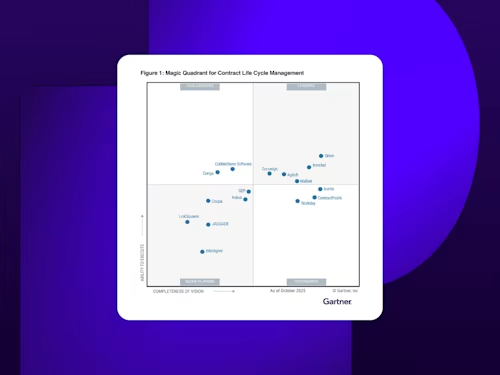
Simplifying Contractual Obligation Management
Understanding the obligations in each of your business contracts is essential. Learn the risks of manual contract management and how Docusign CLM can help.

Contract management solutions help streamline the contract lifecycle by automating manual tasks, centralizing storage and standardizing workflows. The contract process does not end when a contract is signed. For rapidly growing organizations managing a high volume of contracts, the process of tracking and managing contractual obligations is another aspect of the contract lifecycle that can easily overwhelm legal teams tasked with ensuring the business satisfies these commitments.
Managing obligations without the right tools can be difficult and tedious, especially when trying to identify and track contracts at scale. Most customers do this completely manually today, or not at all, which leaves them vulnerable to mistakes and oversights that result in revenue leakage, regulatory and financial risk, and missed opportunities for savings.
In this blog we explore common contract obligation management challenges and how contract management tools can help simplify this process even as the volume of contracts increases.
What are contractual obligations?
A contract is an agreement between parties creating mutual obligations enforceable by law. A contractual obligation can come in different forms, including the completion of certain tasks, avoidance of certain acts, delivery of products or services, and compensation. Parties that fail to fulfill their obligations may face legal consequences. Tracking obligations helps companies stay compliant and reduce their contractual risk.
These obligations can be as straightforward as payment terms (Tenant will pay rent no later than the 5th of every month) or can be as nuanced as detailed ongoing encryption requirements related to data privacy standards.
Common obligation types include:
Background check required
Certificate of insurance required
Compliance terms
Credits/Penalties/Refunds
Invoicing and payment terms
Notice requirements
Publication of uptime availability
Restrictive covenants
Service level commitments
Termination requirements
Common contract obligation management risks
The following are a few of the common contract obligation management risks that businesses could face without a streamlined way to identify, track and report on contract obligations. Each of these risks presents the potential for significant financial, regulatory, and reputational problems for the organization.
Delivery/compensation errors
Without proper visibility into contract obligations, the company completes a sale but fails to provide the service to the customer in a timely manner. Similar errors could be made regarding the quality or completeness of the service. Along the same lines, the company may also activate the service but fail to collect payment correctly.
The risk to the company here is that they are in violation of their contract. This could result in steep penalties or the contract itself being voided. At best, it reflects poorly on the professionalism of the company and provides the client with poor customer service.
Unenforced obligations
Depending on activity that happens after activation, customers may owe the company penalties or fees for additional services, exceeded thresholds or missed obligations. If the company doesn’t have a firm grasp of the contents of its agreements, it will miss these opportunities for additional revenue.
In the case of not collecting on penalties owed, the company risks losing out on additional revenue while allowing the client to violate the agreement.
In the case of not collecting fees for additional services, the company loses out two times over: both in the uncollected fees and in the additional resources spent providing the additional services.
In both scenarios, if these missing payments are only noticed after the fact, enforcing them may come as a frustrating surprise to the client, potentially souring the business relationship.
Auto-renewal clauses
Without a simple way to track contract renewal dates across the entire contract portfolio, companies can become locked into expensive contracts for longer than desired. An aggregated view of contract obligations with vendors gives the business more time to assess the relationship and enter the renewal negotiation with more leverage to potentially:
Renegotiate payment and delivery terms
Lower costs
Leverage volume discounts
Increase performance levels
Address issues with the relationship
But the impact of a missed auto-renewal is more than simply a missed opportunity to achieve better contract terms. Depending on the size of the contract, it could cost the company thousands or even millions of dollars in unapproved costs and potentially derail any agreements with new vendors chosen to perform the same service.
Obligation Management in Docusign CLM

Obligation Management in Docusign CLM lets you track specific contractual commitments within your agreements with vendors or customers. You can capture and report on obligations such as payment due dates, contract terms, renewals, and certificate of insurance requirements. Obligation management helps to reduce risk both pre and post signature. You can capture an obligation on any document in CLM.
Learn more about Docusign CLM.
Austin Miller is a director of product marketing at Docusign.
Related posts
Docusign IAM is the agreement platform your business needs


